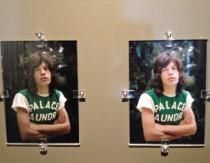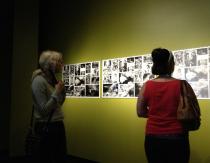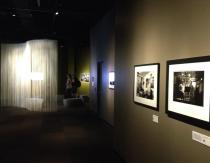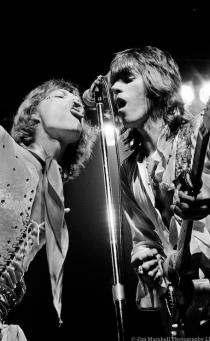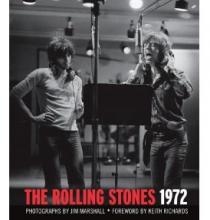As this long, hot summer continues to rock much of the country, the super-cool visual treats from JMPLLC continue to roll as well with the recent launch of the uniquely satisfying “The Rolling Stones 1972, Photographs by Jim Marshall” exhibition at Seattle’s dynamic Experience Music Project Museum. We’ve chosen with this blog to run a few shots of the EMP exhibit to convey how differences in behind-the-scenes decisions, such as printing, framing, and how the show is displayed, can impact the photographer’s original intent and, hence, the viewer’s experience of the image when it’s published and presented in a gallery space. Michelle Dunn Marsh, who handles exhibitions and publications for JMPLLC and served as guest curator for the EMP exhibit, describes the show’s approach which was also tailored for EMP’s groovy, cutting-edge and interactive angle to exhibitions:
“All of photo printing is an interpretation about what the photographer wants the feel of the image to be. The Palace Laundry color proofs of Jagger are hung side by side to show how ink can totally change the mood of a photograph. The one on the right, the lighter image, looks like the prints of Jim’s that I had seen, including a dye transfer, which is the most stable form of color photographic print. Once you achieve what you want in a dye transfer print it will stay that way. “The print on the left is the proof we started with which is just a direct scan from the slide. It’s much darker and still an interesting photo. But you can clearly see that, in the one on the right, Jagger looks innocent, perhaps a bit tired and sweet where in the print on the left he looks aggressive.”
One of the main things I remember first learning about photography from Jim back in the day was his reverence for black-and-white images and disdain for his own color work. Like most of the photographers I have met of his generation, they just really seem very uncomfortable with color. Maybe it was a feel thing and straight-ahead visual preference, or maybe it was that color film was unstable, the photographers had so much less control when turning over the precious negs and slides to a lab and then trusting that the developers wouldn’t screw them up. For Jim, black and white was the truth and color was … well something far less than that, but I can't help thinking that he would really dig the way that conflict is underscored and dealt with in this great exhibit.
Here’s a wonderfully exuberant recounting of the EMP exhibit’s visual impact from one of the folks at indie-pop mag blog, Three Imaginary Girls: “Since I know next-to-nothing about photography and famous photographers, I had never heard of Jim Marshall before I stepped into the new The Rolling Stones 1972, Photographs by Jim Marshall exhibit. (Obviously, though, I had heard of the Stones). Luckily, guest curator Michelle Dunn Marsh was on hand to tell me all about Jim, share details of the photos, and just generally amaze me. “EMP’s Curatorial Director Jasen Emmons helped it all come together by providing a history of the band—and to complement Marshall’s photos with a lovely centerpiece from the museum’s collection: the original artwork for Exile on Main Street, which is unbelievably awesome. “But enough about that; let’s get to the actual PHOTOS. There are so many to gawk over! I spent a long time looking at each one, and probably still didn’t really SEE everything. Candid snaps of The Stones backstage, images of the band performing (in like, the best. outfits. ever. Eyelet jumpsuit, anyone?), and a few publicity photos: one of my favorites being Mick in a Palace Laundry tee. I swear to you, hipsters are going to walk into that exhibit and pass out because Mick was setting style trends for them before they were even born.” Michelle Dunn Marsh adds, “Working on this exhibition, I was thrilled to have the opportunity to show not only the fine arts photographs but also the elements of the processes that underscore how we see photography from RC (resin-coated) prints to book proofs to vintage and modern black-and-white silver gelatin prints.
“The exhibit is not only the history of The Stones it’s a little history of photography. Jim never took museum shows that seriously, but I think he would be tickled to see how pure and powerful his work is in this context.”
And, if you’re lucky enough to make it to the EMP in Seattle before January 6 of next year, you will be, too.
- Jim Marshall Photography LLC Newsroom blog
- Log in to post comments
